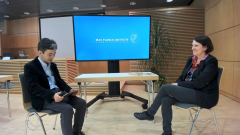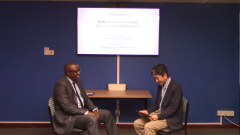Magnetics + Mechanics + Nanoscale = Electromagnetics Future - Greg P. Carman: IEEE Magnetics Distinguished Lecture 2016
Professor Greg P Carman, of the UCLA Active Materials Laboratory, presents this distinguished lecture entitled: Magnetics + Mechanics + Nanoscale = Electromagnetics Future, addressing why we need smale scale magnetic devices and philosphy behind the science.
Efficient control of small scale magnetism presents a significant problem for future miniature electromagnetic devices. In most macroscale electromagnetic systems we rely on a discovery made by Oersted 200 years ago where an electrical current through a wire creates a distributed magnetic field. While this concept works well at large scale, it suffers significant problems at volumes below 1 mm3. One approach to control nanoscale magnetic states is spin-transfer torque (STT). However, experimental measurements on STT memory devices indicates that 100 fJ is required to reorient a bit of memory with an energy barrier of about 0.5 aJ, i.e., at 0.0005 percent efficiency. Therefore, new nanoscale approaches are needed for future miniature electromagnetic devices. Recently, researchers have explored strain-mediated multiferroic composites to resolve this problem. For this material class, a voltage-induced strain alters the magnetic anisotropy of the magneto-elastic elements. These strain-mediated multiferroics consists of a piezoelectric material coupled to magneto-elastic elements to transfer electrical energy to magnetic energy through a mechanical transduction. The coupling coefficient (energy transferred) in piezoelectric materials (e.g., lead zirconate titanate, PZT) is approximately 0.8 while the coupling coefficient in magneto-elastic materials (e.g., Tb-Dy-Fe, Terfenol-D) is of similar magnitude, 0.8. Thus, the amount of energy to overcome a 0.5 aJ bit barrier is potentially only 0.8 aJ, or an efficiency of about 60 percent, neglecting line losses. This presentation reviews the motivation, history, and recent progress in nanoscale strain-mediated multiferroics. Research descriptions include analytical and experimental work on strain-mediated multiferroic thin films, single magnetic domain structures, and superparamagnetic particles. The results indicate efficiencies orders of magnitude superior to STT approaches and presents a new approach to control magnetism. Discussions of future research opportunities and novel applications are included.
Professor Greg P Carman, of the UCLA Active Materials Laboratory, presents this distinguished lecture entitled: Magnetics + Mechanics + Nanoscale = Electromagnetics Future, addressing why we need smale scale magnetic devices and philosphy behind the science.
 Cart
Cart Create Account
Create Account Sign In
Sign In






